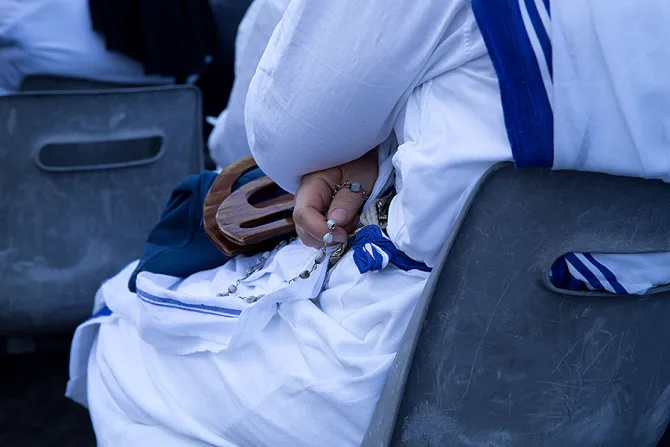Kolkata, India, Jul 11, 2017 / 05:04 am
The Missionaries of Charity have patented the white and blue sari designed by Saint Teresa of Calcutta, obtaining a legal copyright recognizing the pattern as the intellectual property of the order.
Although it was never officially announced, the copyright had been granted the same day as Mother Teresa's Sept. 4, 2016 canonization as the culmination of a three year legal process.
According to the Press Trust of India, intellectual property attorney Biswajit Sarkar said that "the blue-designed border on the sari worn by nuns of Missionaries of Charity was recognized as Intellectual Property for the organization on September four, 2016, the day the Mother was canonized."
"The Missionaries of Charity does not believe in publicity and as such it was not publicized," he said, while stressing that "we are witnessing unscrupulous and unfair usage of the design across the globe" and so are trying "to spread awareness among people about the trademark."
The sari, which is the habit of the Missionaries of Charity sisters, was designed by Mother Teresa when she went to the streets in 1948 to serve the poor. It is white with three blue stripes, the outer stripe being larger than the inner two.
Mother Teresa's blue border pattern "is a distinctive symbolic identity of (the) Missionaries of Charity under the concept of color trade mark protection," Sarkar said.
The sisters sent their application to the Trade Marks Registry of the Indian government in December 2013, and after a three-year "stringent test of legal proceedings" the copyright registration was granted to coincide with the same day as Mother Teresa's canonization, despite the fact that it was a Sunday.
According to Sarkar, the copyright of the pattern of the saris worn by the Missionaries of Charity is unique, and marks the first time a uniform has been protected under intellectual property rights.
In an explanation of the meaning of the saris on the Missionaries of Charity website, Sr. Gertrude, the second nun to join the Missionaries of Charity after their foundation and who is since deceased, reflected on the symbolism of the design and how it came about.
She wrote that when she joined Mother Teresa April 26, 1949, "it was then that for the very first time in my life I saw her in her white sari with three blue borders."
"And what a shock it was for me – Mother Teresa, a Loreto nun, my Headmistress was now dressed like a poor Bengali woman in a simple white cotton sari with three blue borders!" she said.
The shops where the nuns bought their first habits sold the white sari with either red, green or blue borders, and "Mother selected the blue border, for we associate the color blue with Mother Mary. It stands for purity."
"Also in those days women who swept the streets used to wear a similar kind of a sari," she said. "So Mother adopted a religious dress that was both symbolic and practical – it not only helped to identify ourselves with the poor, but was also suitable to Calcutta's searing climate."
The sisters initially paid about 2.50 rupees ($0.04) for their saris, but once the order began to grow, it became hard to get them in large numbers.
Because of this, when the sisters in 1958 started the Gandhiji Prem Niwas project for leprosy patients, they noticed that many were out of work, and so bought looms and began paying the lepers to weave the saris for the order.
Since leprosy can't survive outside of human flesh, there was no danger of the nuns getting infected. The patients continue to work under strict medical supervision, and are paid by the sisters, who provide them with food, clothing, and medical care.
(Story continues below)
Regarding the significance of the colors chosen for the sari, the white stands for truth and purity, while the three blue stripes on the border signify the vows that the nuns take: the first represents poverty, the second obedience, and the third, broader band, represents the vows of chastity and wholehearted service to the poorest of the poor.
The cross sewn onto the left shoulder of the habit is symbolic of the fact that for the Missionaries of Charity, Christ on the Cross is the key to the heart.
Novices who join the order wear plain white saris with no stripes. Only after four years of formation, when they are ready to take their vows, do they receive the sari with the blue stripes. Each sister has only three saris.



